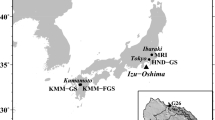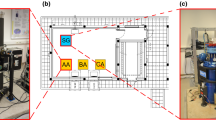Abstract
In spite of the large stability of the fused quartz elastic system, which is utilized in modern relative gravimeters such as Scintrex CG-5, precise gravity measurements need regular calibration mostly because of weak changes in time of the elastic properties of the spring. Calibration of the relative gravimeters is important to avoid the systematic error of scale in relevant observations. In this study, due to the establishment of a large amplitude (of about 1200 mGal) calibration line in Iran, the stability of three CG-3 M and three CG-5 gravimeters has been continuously investigated based on the results of a 12 year (2005–2017) observations. The absolute gravity values at calibration stations were measured during the period 2005–2007 and more recently in 2017–2018 (for most of the stations) with absolute FG5 gravimeters. The results show that the Scintrex gravimeters exhibit different behaviors on the calibration line. The accuracy of determining the calibration coefficient of the gravimeters was better than 40 ppm. According to our results there is no effect of the gravity amplitude itself on the calibration factors. CG-5 #83 and CG-5 #87 have the largest changes in calibration factor (more than 1000 ppm) over the 12 year observation period while CG-3 M #20 and CG-3 M #60 have the smallest range (less than 200 ppm). The misclosure of relative gravity measurements in the first-order gravity network of Iran has been calculated before and after calibration corrections and it is shown that applying the scale factor correction reduced significantly the misclosures on the gravity network.








Similar content being viewed by others
References
Boddice, D., Atkins, P., Rodgers, A., Metje, N., Goncharenko, Y., & Chapman, D. (2018). A novel approach to reduce environmental noise in microgravity measurements using a Scintrex CG5. Journal of Applied Geophysics,152, 221–235.
Bonvalot, S., Diament, M., & Gabalda, G. (1998). Continuous gravity recording with Scintrex CG-3 M meters: a promising tool for monitoring active zones. Geophysical Journal International,135(2), 470–494.
Braitenberg, C., Sampietro, D., Pivetta, T., Zuliani, D., et al. (2016). Gravity for detecting caves: airborne and terrestrial simulations based on a comprehensive karstic cave benchmark. Pure and Applied Geophysics,173(4), 1243–1264.
Budetta, G., & Carbone, D. (1997). Potential application of the Scintrex CG-3 M gravimeter for monitoring volcanic activity: results of field trials on Mt. Etna, Sicily. Journal of Volcanology and Geothermal Research,76(3–4), 199–214.
Carbone, D., Jousset, P., & Musumeci, C. (2009). Gravity “steps” at Mt. Etna volcano (Italy): Instrumental effects or evidences of earthquake‐triggered magma density changes?. Geophysical Research Letters, 36(2). https://doi.org/10.1029/2008GL036179.
Carbone, D., & Rymer, H. (1999). Calibration shifts in a LaCoste-and-Romberg gravimeter: comparison with a Scintrex CG-3 M. Geophysical Prospecting,47(1), 73–83.
Crossley, D., Hinderer, J., & Riccardi, U. (2013). The measurement of surface gravity. Reports on Progress in Physics,76(4), 046101.
Debeglia, N., & Dupont, F. (2002). Some critical factors for engineering and environmental microgravity investigations. Journal of Applied Geophysics,50(4), 435–454.
Dykowski, P. (2012). Calibration of Relative Spring Gravimeters with the use of the A10 Absolute Gravimeter. In Proceedings of the Symposium Gravity, Geoid and Height Systems GGHS2012, Venice, Italy.
Flury, J., Peters, T., Schmeer, M., Timmen, L., Wilmes, H., & Falk, R. (2007). Precision gravimetry in the new Zugspitze gravity meter calibration system. In Proceedings of the 1st International Symposium of the International Gravity Field Service, Istanbul 2006, Harita Dergisi, Special Issue.
Fores, B., Champollion, C., Le Moigne, N., & Chery, J. (2017). Impact of ambient temperature on spring-based relative gravimeter measurements. Journal of Geodesy,91(3), 269–277.
Hatam Chavari, Y. (2010). Etablissement des nouveaux réseaux multi-observations géodésiques et gravimétriques, et détermination du géoïde en Iran. PhD thesis. France: University Montpellier 2.
Jousset, P., Dwipa, S., Beauducel, F., Duquesnoy, T., & Diament, M. (2000a). Temporal gravity at Merapi during the 1993–1995 crisis: an insight into the dynamical behaviour of volcanoes. Journal of Volcanology and Geothermal Research,100(1–4), 289–320.
Jousset, P., Mori, H., & Okada, H. (2000b). Possible magma intrusion revealed by temporal gravity, ground deformation and ground temperature observations at Mount Komagatake (Hokkaido) during the 1996–1998 crisis. Geophysical Journal International,143(3), 557–574.
Nabighian, M. N., Ander, M. E., Grauch, V. J. S., Hansen, R. O., LaFehr, T. R., Li, Y., et al. (2005). Historical development of the gravity method in exploration. Geophysics,70(6), 63ND–89ND.
Oja, T., Turk, K., & Jurgenson, H. (2014). Evaluating the calibration of Scintrex CG-5 spring Gravimeters, Estonian Land Board (ELB). Estonia: Estonian University of Life Science (EULS).
Parseliunas, E., Petroškevičius, P., Obuchovski, R., & Birvydiene, R. (2013). An investigation of the automatic relative gravimeters. In Solid State Phenomena,199, 261–266. (Trans Tech Publications).
Reudink, R., Klees, R., Francis, O., Kusche, J., Schlesinger, R., Shabanloui, A., et al. (2014). High tilt susceptibility of the Scintrex CG-5 relative gravimeters. Journal of Geodesy,88(6), 617–622.
Riccardi, U., Rosat, S., & Hinderer, J. (2012). On the accuracy of the calibration of superconducting gravimeters using absolute and spring sensors: a critical comparison. Pure and Applied Geophysics,169(8), 1343–1356.
Scintrex Ltd. (2005). CG-3 M Autograv automated gravity meter operator manual, P.N: 858700 Version 5.00. Canada: Scintrex Limited, Concord.
Scintrex Ltd. (2012). CG-5 Scintrex autograv system operation manual, part I # 867700 revision 8. Canada: Scintrex Limited, Concord.
Seigel, H. O. (1995). A guide to high precision land gravimeter surveys. Scintrex Limited,222(1), 1–122.
Thompson, R. (1985). A note on restricted maximum likelihood estimation with an alternative outlier model. Journal of the Royal Statistical Society: Series B (Methodological),47(1), 53–55.
Timmen, L., Flury, J., Peters, T., & Gitlein, O. (2006). A new absolute gravity base in the German Alps. In Contributions to Geophysics & Geodesy, Vol. 36 (special issue), 2nd International Gravity Field Workshop Smolenice 2006.
Timmen, L., & Gitlein, O. (2004). The capacity of the Scintrex Autograv CG-3 M no. 4492 gravimeter for “absolute-scale” surveys. Revista Brasileira de Cartografia, 2(56), 89–95.
Tiwari, V. M., & Hinderer, J. (2011). Gravity field, time variations from surface measurements. In: H. K. Gupta (Eds.), Encyclopedia of solid earth geophysics, Part 7 (pp. 489–494). Dordrecht: Springer.
Torge, W. (1989). Gravimetry, edit. Berlin: De Gruyter.
Torge, W., Sevilla, M. J., & Vieira, R. (1988). Mareas Terrestres y fundamentos, métodos y problemas de la gravimetría. Curso de Geodesia Superior,4, 1–301.
Ukawa, M., Nozaki, K., Ueda, H., & Fujita, E. (2010). Calibration shifts in Scintrex CG-3M gravimeters with an application to detection of microgravity changes at Iwo-tou caldera, Japan. Geophysical Prospecting,58(6), 1123–1132.
Vanicek, P., & Krakiwsky, E. J. (2015). Geodesy: the concepts. Amsterdam: Elsevier.
Vieira, R., Camacho, A. G., & Ortiz, E. (2002). Global adjustment for the gravity calibration line Madrid-Valle de los Caídos. Física de la Tierra,14, 127–159.
Author information
Authors and Affiliations
Corresponding author
Additional information
Publisher's Note
Springer Nature remains neutral with regard to jurisdictional claims in published maps and institutional affiliations.
Rights and permissions
About this article
Cite this article
Cheraghi, H., Hinderer, J., Saadat, S.A. et al. Stability of the Calibration of Scintrex Relative Gravimeters as Inferred from 12 Years of Measurements on a Large Amplitude Calibration Line in Iran. Pure Appl. Geophys. 177, 991–1004 (2020). https://doi.org/10.1007/s00024-019-02300-6
Received:
Revised:
Accepted:
Published:
Issue Date:
DOI: https://doi.org/10.1007/s00024-019-02300-6




